Living in this fast-paced world of digital marketing can sometimes feel like an unending effort to stand out and capture audience attention.
Considering that search engines have become an integral centerpiece in how businesses reach their potential customers, Google Ads has emerged as one of the strongest tools for reaching targeted audiences.
So, how do you make sure your ads speak directly to each unique search query?
This is where Dynamic Keyword Insertion in Google Ads comes into play.
Using DKI, you can enable ads to pick up exactly what is being typed in by a user as their search terms, providing them with a more personalized and relevant experience.
In this post, we take a deep dive into the world of Dynamic Keyword Insertion — from what it is and how it works to effectively setting it up within your campaigns.
Whether you’re a beginner learning about Google Ads or an advanced advertiser looking to optimize your ads further, understanding DKI can transform your campaigns, boost click-through rates, and add sparkle to your ads.
Let’s start by exploring what Dynamic Keyword Insertion is and how it works in Google Ads.
- What is Dynamic Keyword Insertion in Google Ads?
- How to Set Up Dynamic Keyword Insertion in Google Ads
- Maximizing Campaign Performance with Dynamic Keywords
- Challenges and Limitations of Dynamic Keyword Insertion
- Advanced Dynamic Keyword Insertion Strategies
- Wrapping Up How to Dominate Dynamic Keyword Insertion in Google Ads
- Dynamic Keyword Insertion Frequently Asked Questions
What is Dynamic Keyword Insertion in Google Ads?
Dynamic Keyword Insertion is a feature within Google Ads that enables automatic ad text customization based on the user’s entered search terms.
This means that instead of showing a generic ad suitable for anyone, you can provide tailored messages that align more closely with what users are searching for.
DKI accomplishes this by dynamically adding keywords to your ad headline, description, or other ad fields based on the best match for the search term.
This powerful feature helps improve ad relevance and can lead to higher engagement rates.

A digital advertising setup illustrating the concept of Dynamic Keyword Insertion.
Definition and Purpose of Dynamic Keyword Insertion
At its core, Dynamic Keyword Insertion enables you to personalize your ads in real time, adapting to user intent.
The most important reason for using DKI is that it enhances ad relevance.
There’s a much greater likelihood that when users see their search terms reflected back in an ad, they’ll feel the ad directly addresses their needs, making click-throughs more likely.
For example, if you’re running ads for various types of running shoes, DKI can dynamically change the ad headline to either ‘Running Shoes for Men’ or ‘Women’s Running Shoes’ based on the user’s specific search term.

An in-depth look at how Dynamic Keyword Insertion customizes ads.
How Dynamic Keyword Insertion Works in Ads
When creating an ad, you use a special code that signals Google to insert the searcher’s keyword into the ad text.
This code may look something like {Keyword:Default Text}, where ‘Default Text’ serves as a fallback option in case the search term cannot be used, for example, if it’s too long.
Google then substitutes this placeholder with the search term that triggered the ad, as long as it fits within the character limit.
This dynamic adjustment allows ads to appear highly relevant to users, potentially improving your Quality ScoreA Google Ads metric that measures ad relevance, landing page quality, and expected click-through rate. and ad positioning.
- Increased Relevance: DKI aligns your ad text with user searches, improving relevance.
- Higher Click-Through Rates: Relevant ads generally attract more clicks, boosting CTR.
- Enhanced User Engagement: Ads reflecting user queries feel personalized, encouraging engagement.
Using Dynamic Keyword Insertion thoughtfully within campaigns can be one of the most impactful ways to connect with your audience.
In turn, this gives users the sense that your ad has been crafted with their needs in mind.
However, as we will explain in the following sections, knowing how and when to use Dynamic Keyword Insertion effectively can make a huge difference in your campaign performance.
Dynamic Keyword Insertion (DKI) helps improve ad relevance by allowing Google Ads to match ad content directly with user search terms, offering a personalized experience.

Setting up Dynamic Keyword Insertion in Google Ads with campaign customization.
How to Set Up Dynamic Keyword Insertion in Google Ads
Setting up Dynamic Keyword Insertion (DKI) in Google Ads is relatively simple and can bring significant value to your ad campaigns by automating ad text personalization based on users’ search queries.
However, to fully benefit from DKI, it’s essential to understand the proper steps and finer details involved.
When DKI is set up correctly, your ads will be more relevant and engaging, which can raise click-through rates and, in turn, improve your Quality Score.
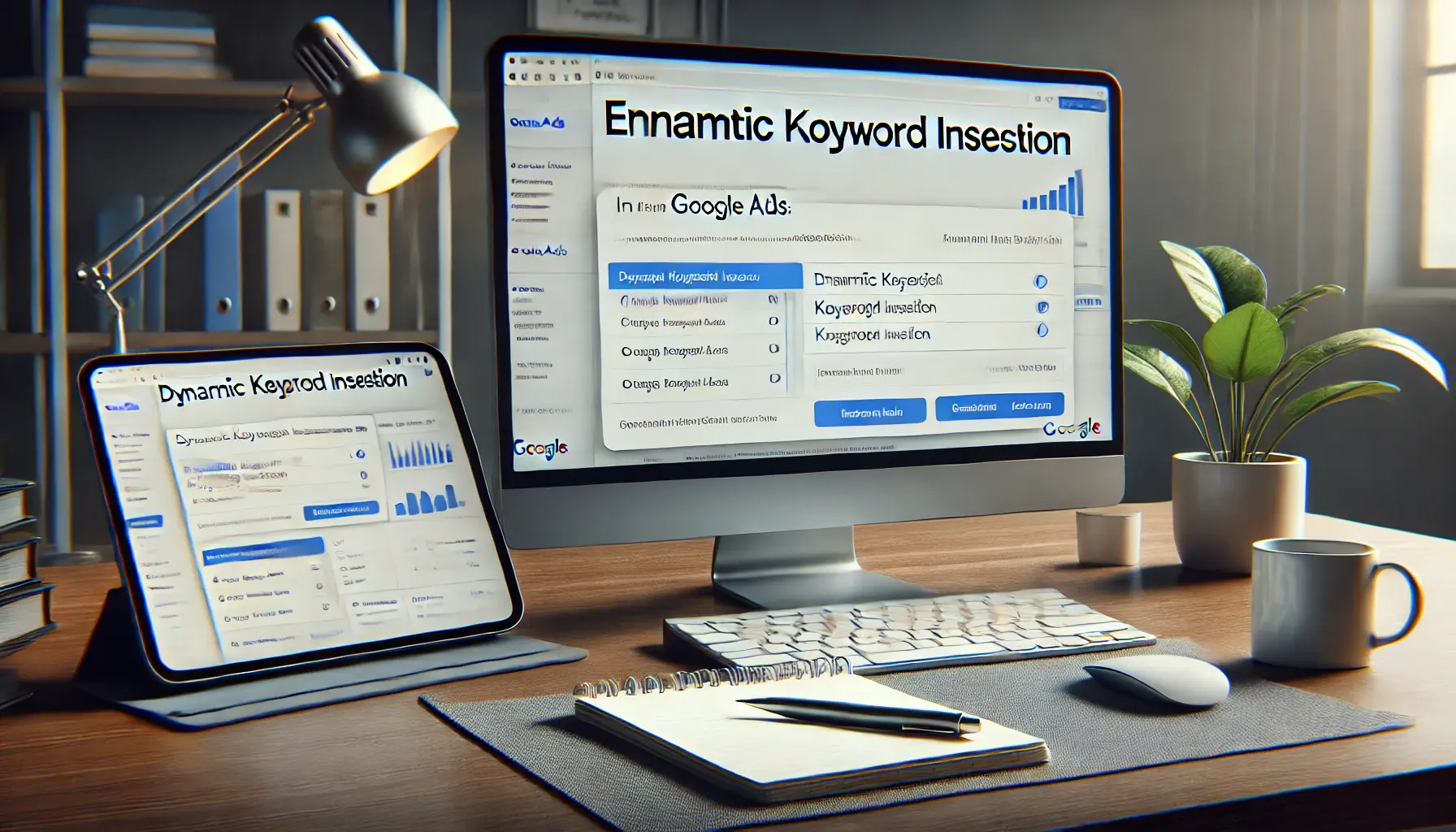
Enabling Dynamic Keyword Insertion in Google Ads for enhanced ad relevance.
How to Enable Dynamic Keyword Insertion
To enable Dynamic Keyword Insertion, begin by creating a new text ad within your Google Ads account.
Once you reach the section where you input your headlines and descriptions, insert the DKI code in the ad text.
The typical syntax is {Keyword:Default Text}.
Here’s how it works:
- Step 1: Access your Google Ads account and create a new text ad.
- Step 2: When writing the headline or description, type in {Keyword
- Step 3: Customize the default text. This text will appear if the search term doesn’t fit due to character limits or other restrictions.
- Step 4: Preview your ad to ensure the DKI works as intended and stays within character limits.
- Step 5: Save your ad and monitor its performance regularly.
It’s essential to choose a default text that supports your ad’s objective and message, as this will appear when DKI cannot display the keyword due to character constraints.
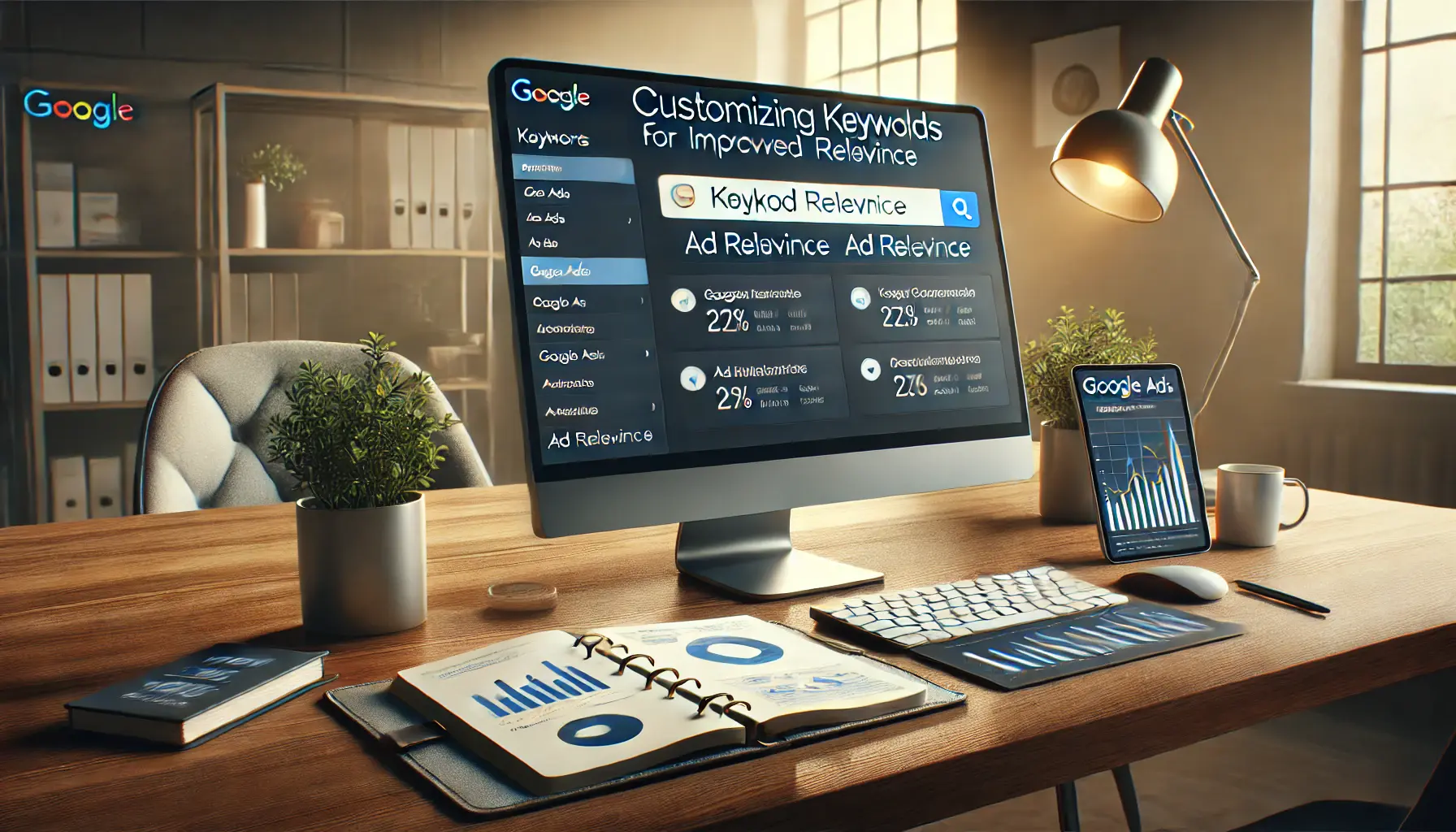
Optimizing ad relevance by customizing keywords in Google Ads.
Customizing Keywords for Better Ad Relevance
To make the most of Dynamic Keyword Insertion, it’s important to carefully select keywords and default text.
Ensure that the keywords used with DKI align with user intent and the product or service advertised.
Additionally, tailor the default text so that your ads remain meaningful and relevant when the specific search term cannot be displayed.
This approach maintains relevance and creates an ad that still captures interest even if the exact search term isn’t shown.
For example, if you’re marketing a range of fitness products, you could use a default text like “Top Fitness Gear” to maintain interest when the search term doesn’t fit due to length constraints.
This balance of relevance and messaging consistency helps provide a seamless user experience.

Implementing best practices for creating effective dynamic ads in Google Ads.
Best Practices for Creating Great Dynamic Ads
Effective Dynamic Keyword Insertion relies on best practices to ensure your ads perform well:
- Choose Keywords Wisely: Use keywords that directly relate to your ad group to avoid creating irrelevant ads.
- Avoid Overuse of Capitalization: Excessive capitalization can make an ad look spammy, lowering credibility. Use standard capitalization for professional-looking ads.
- Test Different Versions: Experiment with different versions of your ad to see which headlines and descriptions perform best with DKI.
- Keep Character Limits in Mind: DKI may not display the keyword if it exceeds character limits, so preview your ad to ensure readability.
- Monitor Regularly: Check your ad performance metrics frequently to gauge effectiveness and identify areas for improvement.
Following these best practices helps ensure that your Dynamic Keyword Insertion strategy remains effective and user-friendly, aligning with user expectations and enhancing the success of your campaigns.
Setting up DKI involves creating text ads with dynamic placeholders that adapt to search terms. It’s an easy setup that provides significant campaign value.

Optimizing campaign performance through dynamic keywords in Google Ads.
Maximizing Campaign Performance with Dynamic Keywords
Once the setup for Dynamic Keyword Insertion is complete, the next task is to optimize your campaigns for maximum performance.
While dynamic keywords can greatly enhance your ad relevance and click-through rateA metric showing how often people click on an ad after seeing it., their full potential requires a continuous process of monitoring, testing, and refinement.
When properly implemented, DKI can transform your ads into strong, highly engaging messages that connect directly with what users are searching for.
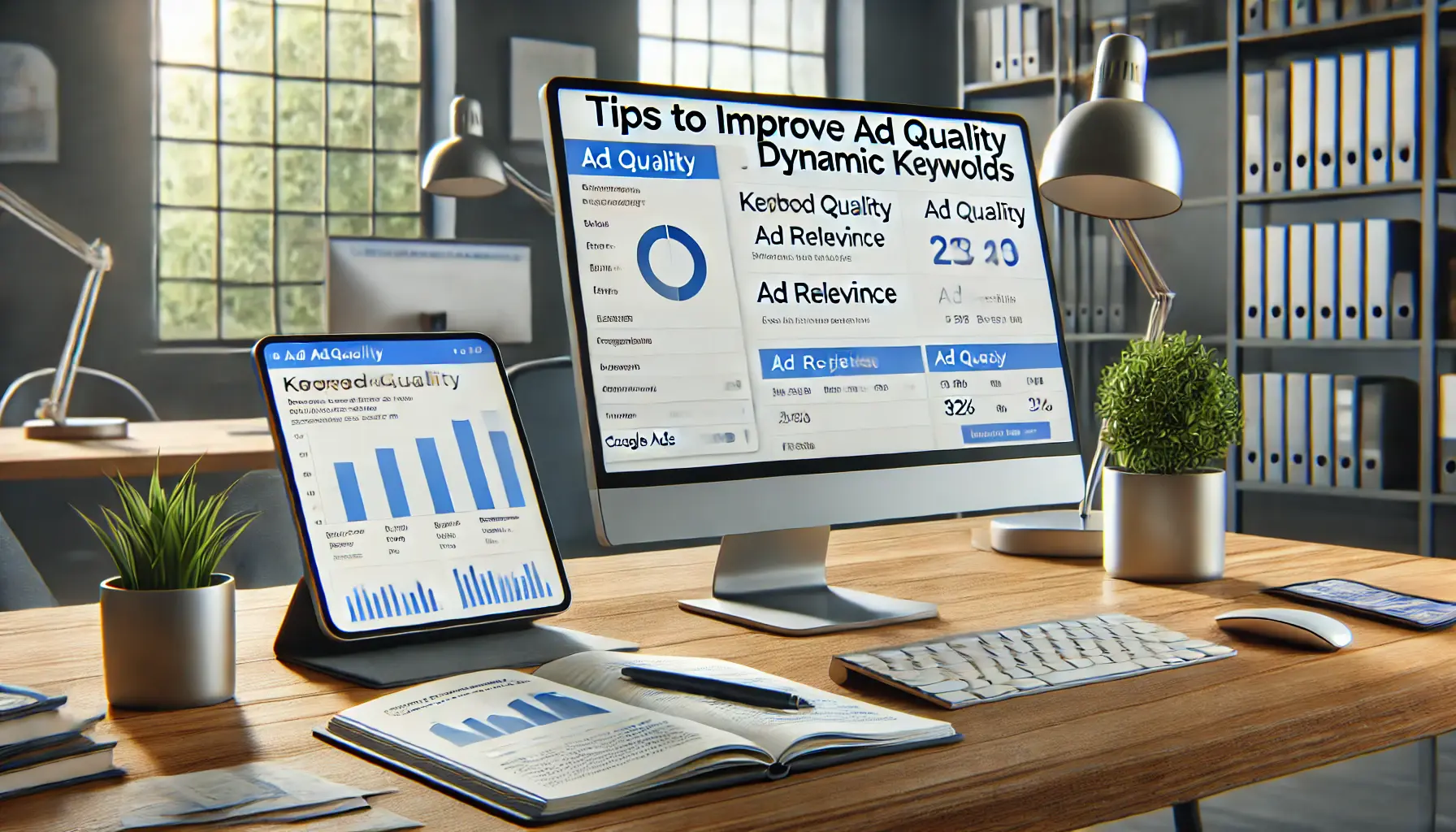
Enhancing ad quality with dynamic keywords in Google Ads.
Tips to Improve Ad Quality Using Dynamic Keywords
Improving ad quality with Dynamic Keyword Insertion involves a strategic approach to keyword management and thoughtful ad construction.
These tactics can help you get the most out of DKI:
- Use High-Intent Keywords: Apply keywords that demonstrate clear intent—keywords users might be ready to act on, whether to buy or learn more about.
- Ensure Relevance: Structure your ad groups so that DKI keywords remain relevant to each particular ad, further improving both ad performance and user experience.
- Optimize Ad Copy: Construct ad text that accommodates dynamic keywords naturally, ensuring a smooth and engaging message regardless of which keyword appears.
- Utilize Negative Keywords: Add negative keywords to prevent your ad from appearing in unrelated searches, helping refine your targeting.
These tactics ensure that your Dynamic Keyword Insertion strategy supports high-quality ads that effectively capture users’ attention.

Aligning keyword variations with user intent in Google Ads.
Using Keyword Variations to Match User Intent
Selecting keywords that vary based on what users might type helps you match user intent.
Using variations that capture user needs precisely can create an ad that feels personal and relevant.
For example, if you’re selling “smart home devices,” you could set up variations such as “smart lights” or “home security,” which align more closely with user intent.
This flexibility increases the likelihood that users will find your ad relevant, thus boosting your click-through rate.
Consider using long-tail keywordsMore specific, longer keyword phrases often with lower search volumes but higher conversion rates. with DKI to capture more specific intent.
Long-tail keywords often face less competition, which can lower your costs while making your ad more relevant to searchers.

Optimizing campaign performance through monitoring and adjustments in Google Ads.
Monitoring and Adjusting Campaigns for Optimal Results
Dynamic Keyword Insertion can greatly enhance your campaigns, but close monitoring and adjustments are essential.
Regularly check metrics like click-through rates (CTR), Quality Score, and conversion rates to identify which dynamic keywords perform best and which may need adjustment.
Here’s how you can optimize for better results:
- Adjust Bids: Increase bids for keywords showing high engagement and conversions to drive more traffic to successful ad variations.
- Refine Keywords: Remove underperforming keywords and focus on those that generate high-quality leads.
- Test New Variations: Regularly test new keyword variations to keep your ad copy fresh and relevant to changing user interests.
These regular performance adjustments help ensure that Dynamic Keyword Insertion campaigns stay optimized, boosting ad reach and effectiveness.

Showcasing success stories in digital ads using dynamic keywords.
Case Studies: Success Stories with Dynamic Keywords
Many advertisers have reported increased ad performance with Dynamic Keyword Insertion.
By personalizing ads to align with search intent, brands have seen boosts in click-through rates and conversions.
For example, a retail brand that used DKI to match seasonal search trends saw a 20% increase in CTR and a 15% improvement in conversions over three months.
Another case study showed that a service provider used DKI to adapt ad copy to local searches, resulting in higher engagement from targeted regions.
These success stories highlight that Dynamic Keyword Insertion is an effective tool for enhancing ad relevance, resonating with audiences, and driving higher engagement.
Regular monitoring and testing are key to maximizing the performance of campaigns using dynamic keywords.

Exploring the challenges and limitations of Dynamic Keyword Insertion in ad campaigns.
Challenges and Limitations of Dynamic Keyword Insertion
Though Dynamic Keyword Insertion (DKI) is a powerful tool for creating relevant ads, it comes with challenges and limitations that advertisers need to keep in mind.
Overdependence on DKI or poor implementation can result in ads that fall flat, making it essential to understand some of its potential pitfalls.
Recognizing the limitations of DKI can help you use it more effectively, ensuring your campaigns remain relevant and successful.

Analyzing the potential drawbacks of Dynamic Keyword Insertion in advertising campaigns.
Potential Drawbacks of Dynamic Keyword Insertion
Although Dynamic Keyword Insertion can improve ad relevance, there are some notable drawbacks:
- Risk of Irrelevant Ad Copy: If the dynamically inserted keywords aren’t carefully selected, the resulting ad copy might appear nonsensical or out of context, reducing its impact and potentially confusing users.
- Keyword Stuffing Issues: When too many keywords are used, DKI ads can end up looking cluttered, unappealing, or even spammy, which may lower your ad Quality Score.
- Branding Consistency: DKI focuses on flexibility, but this can sometimes compromise branding, especially if certain keywords misalign with your brand’s voice or values.
These potential drawbacks highlight the importance of a strategic approach when using Dynamic Keyword Insertion to ensure your ads stay relevant and effective.
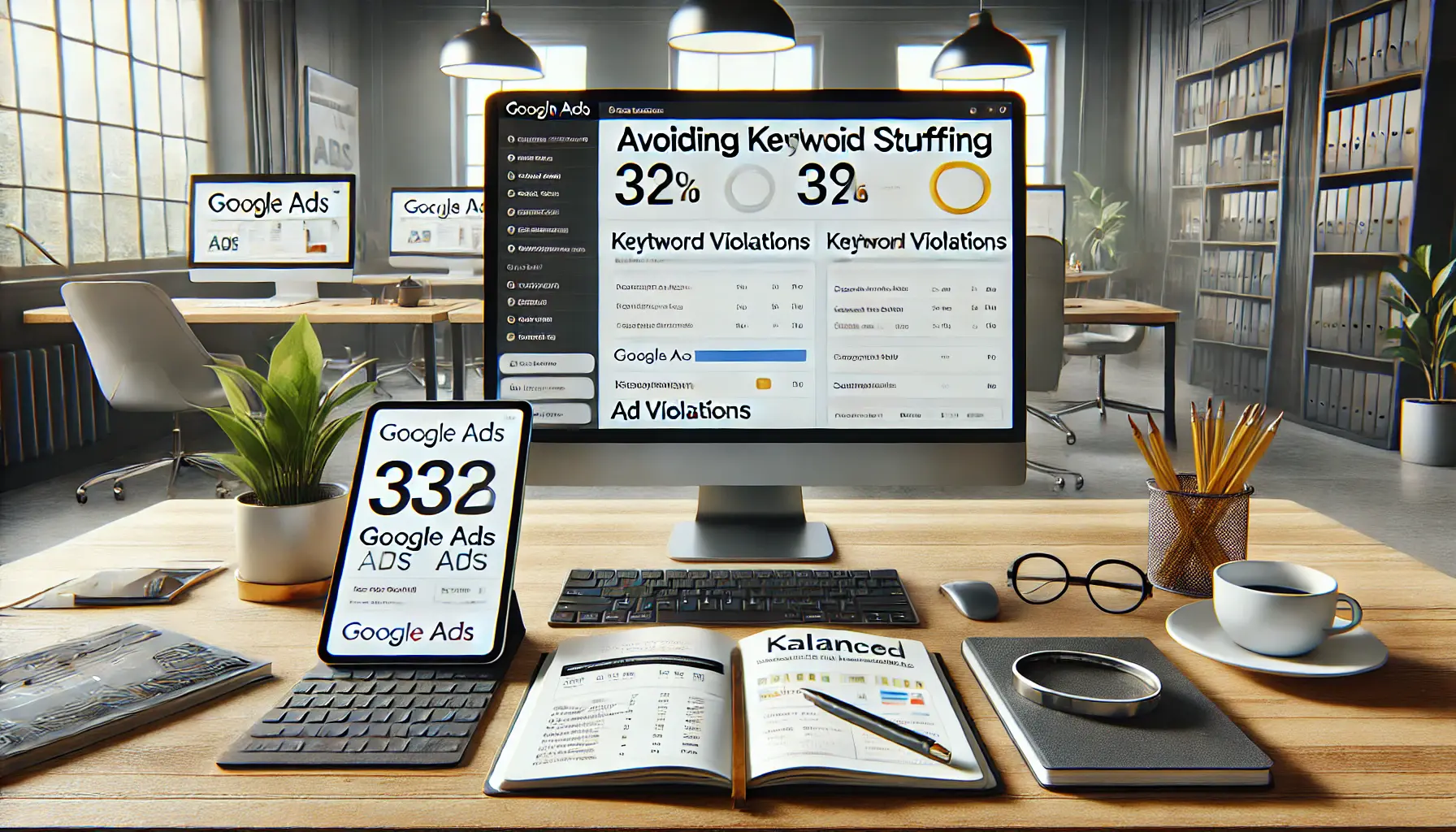
Maintaining ad quality by avoiding keyword stuffing and adhering to ad guidelines.
Avoiding Keyword Stuffing and Ad Violations
One common challenge with DKI is keyword stuffing, where ads become overloaded with keywords in an attempt to match every search query.
This approach often results in low-quality ads lacking a clear or engaging message, which can lower Quality Scores and increase costs.
Google has policies against keyword stuffing, and excessive keyword use can lead to ad disapproval or account penalties.
To avoid this, use a targeted selection of high-intent keywords that naturally fit within your ad copy.
By focusing your ads and keeping them concise, you can maintain both relevance and adherence to Google’s guidelines.
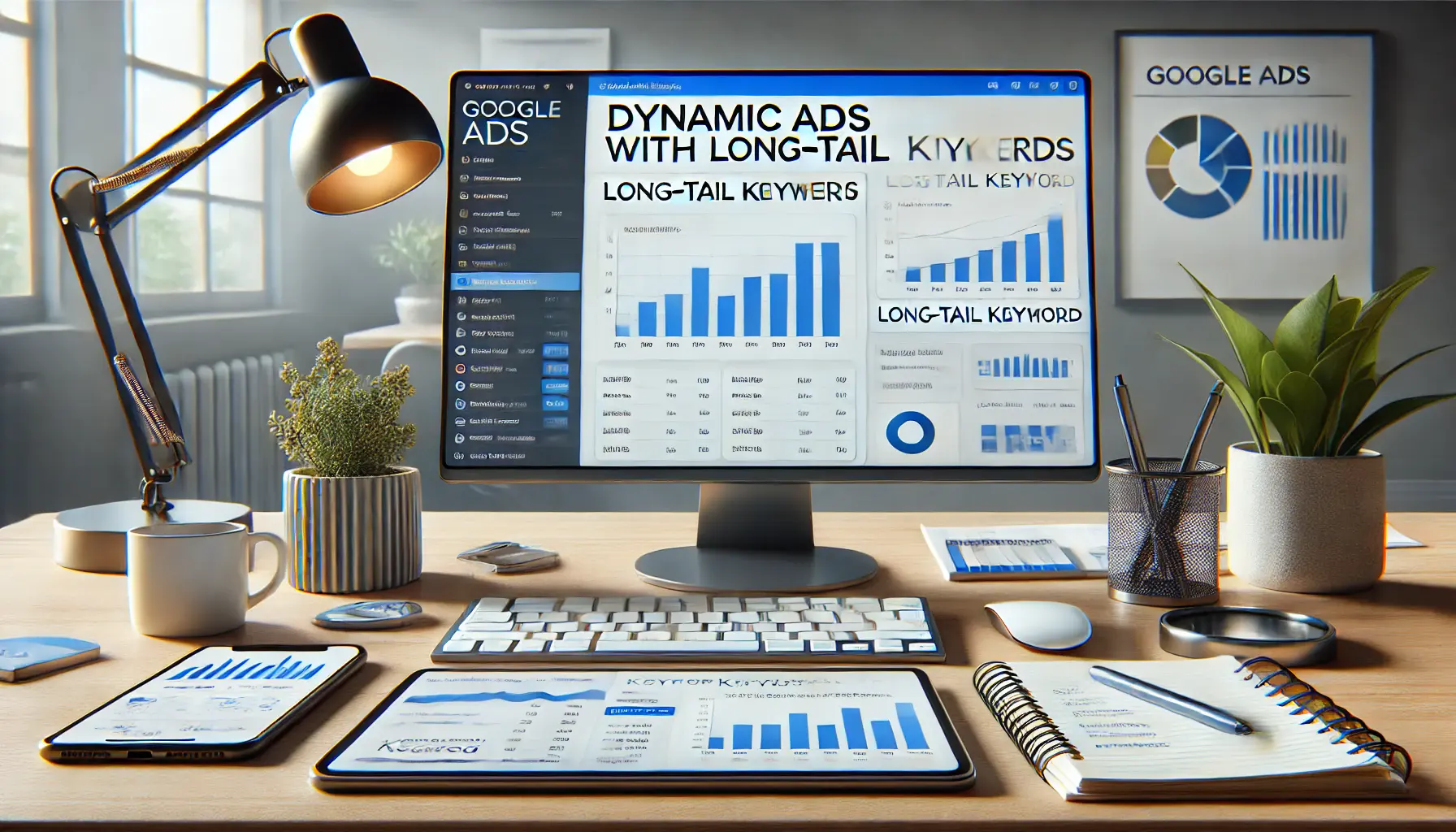
Optimizing dynamic ads through the use of long-tail keywords in Google Ads.
Handling Dynamic Ads with Long-Tail Keywords
Long-tail keywords can be highly effective for targeting niche traffic, but they may create challenges when used with Dynamic Keyword Insertion.
Long-tail keywords may exceed character limitsThe maximum allowed number of characters in Google Ads text fields. or make ad copy appear overly specific or awkward.
Additionally, since long-tail keywords are often less frequently searched, they might not yield optimal results when combined with DKI.
Consider creating dedicated ad groups for long-tail keywords that don’t use DKI.
This approach allows for more tailored ad copy, ensuring your message remains clear and relevant.
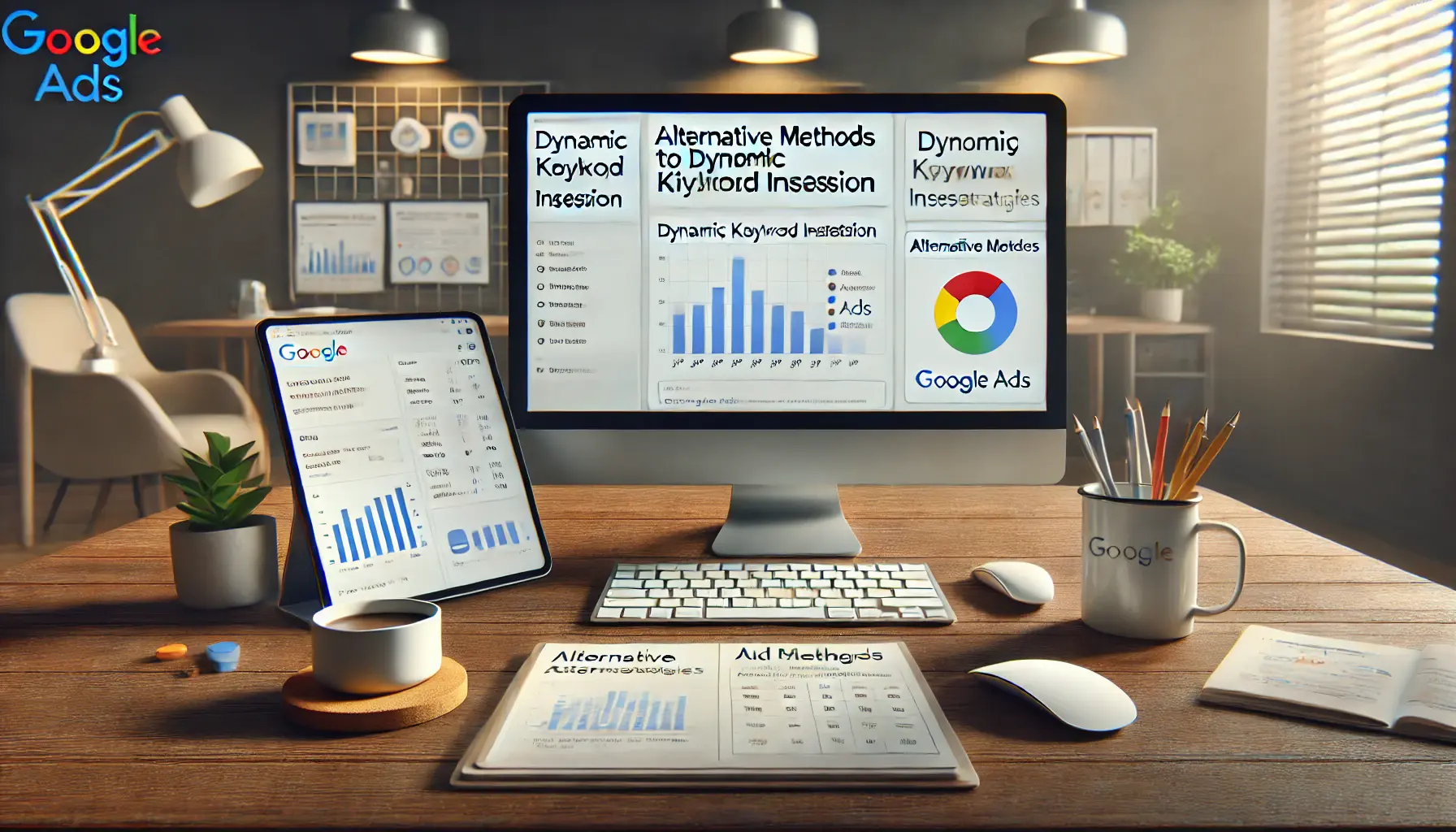
Exploring alternative strategies to Dynamic Keyword Insertion in Google Ads.
Alternatives to Dynamic Keyword Insertion
If DKI doesn’t suit your campaign needs, several alternative strategies can provide similar benefits:
- Ad Customizers: These allow you to dynamically insert variables such as location or product names, tailoring ads based on user context without relying on keyword-based customization.
- Responsive Search Ads: This format enables you to create multiple headlines and descriptions that Google automatically tests, improving ad relevance through machine learning.
- Manual Keyword Optimization: For campaigns with strict messaging needs, consider creating static ads with carefully chosen keywords to maintain control over ad content.
Using these alternatives offers a balance of personalization and control, making them useful tools for achieving high-quality ads without relying solely on Dynamic Keyword Insertion.
While DKI is effective, it may lead to irrelevant ad copy or keyword stuffing if not managed correctly.
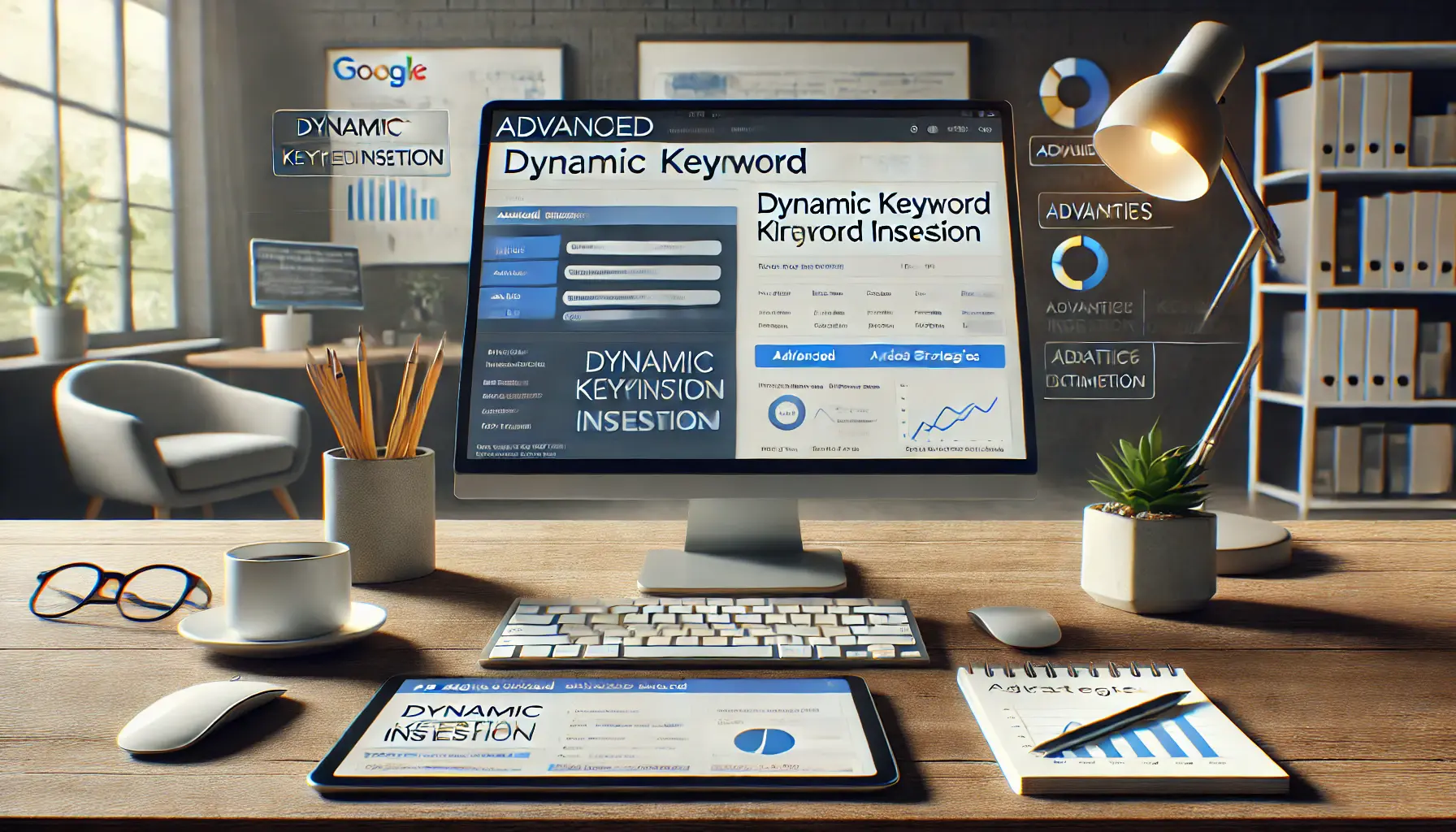
Implementing advanced strategies for Dynamic Keyword Insertion in Google Ads.
Advanced Dynamic Keyword Insertion Strategies
Once you’ve mastered the basic elements of Dynamic Keyword Insertion (DKI), it’s time to move on to advanced techniques that can further enhance your campaign performance.
In this section, you’ll learn how to combine DKI with other tools and techniques offered by Google Ads to create highly targeted and personalized ads that resonate even more with your audience and adapt to specific contexts.
These sophisticated strategies can help increase your ad relevance and performance, yielding better results for your campaigns.

Combining dynamic keywords with ad customizers for personalized Google Ads campaigns.
Using Dynamic Keywords with Ad Customizers
Ad customizers allow you to dynamically insert specific details into the ad copy, such as pricing, countdowns, or product names, based on factors like location or user behavior.
By combining DKI with ad customizersA Google Ads feature allowing ads to include dynamic elements like location or product details., you can create highly relevant, timely ads that align with users’ intentions.
For example, you could create an ad that automatically inserts keywords based on search terms while including location-specific information to target local audiences more effectively.
The use of ad customizers together with Dynamic Keyword Insertion keeps your ads fresh, relevant, and precisely matched to each user’s needs, maximizing the chances of successful conversions.
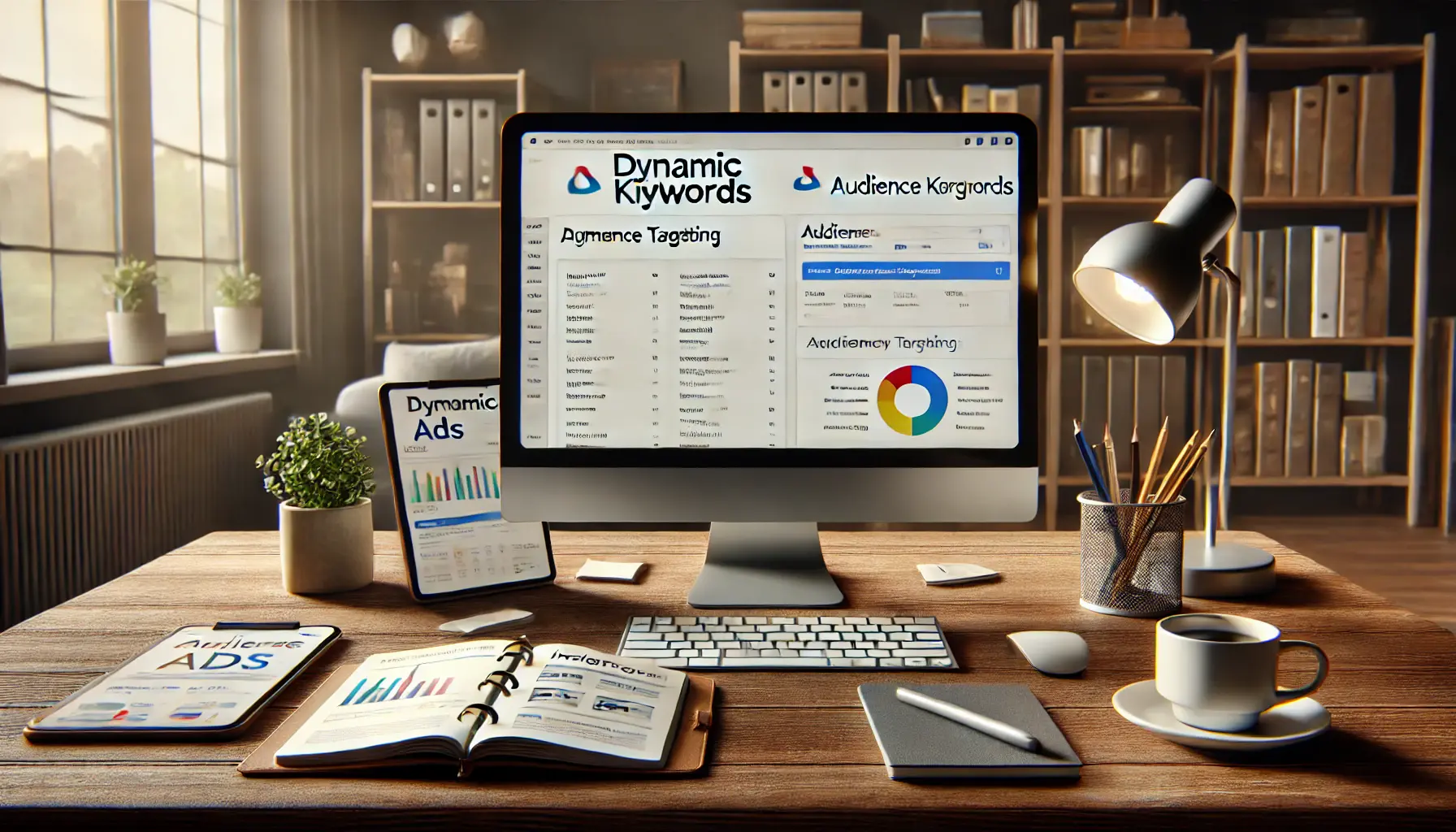
Integrating dynamic keywords with audience targeting for precise ad customization.
Combining Dynamic Keywords with Audience Targeting
Audience targeting enables you to reach specific user groups based on their online behavior, demographics, and interests.
With Dynamic Keyword Insertion interacting with audience targeting, your ad messaging becomes more granular, displaying messages that resonate with each audience segment.
For instance, an ad targeting frequent travelers might use DKI to insert keywords like “last-minute flights” or “discounted hotels,” creating a more personalized ad experience that speaks directly to this audience’s needs.
This approach can lead to higher engagement and conversions, as it addresses the specific interests and search intents of users more effectively.

Testing different dynamic keyword formats in Google Ads for optimized results.
Experimenting with Dynamic Keyword Formats
In Dynamic Keyword Insertion, it’s also possible to experiment with different keyword formats, such as title case or sentence case, to find the style that performs best.
For instance, title case (e.g., “Buy Running Shoes”) may appear more formal, while sentence case (e.g., “Buy running shoes”) may come across as friendly and casual.
Testing various formats allows you to discover what resonates most with your target audience, helping you optimize for clicks and conversions.
To further enhance ad quality, ensure that your keyword format aligns with your brand’s tone and messaging style.
This consistency positively impacts brand perception and overall ad performance.
Monitoring and analyzing dynamic keyword performance in Google Ads.
Tracking and Analyzing Dynamic Keyword Performance
One of the keys to successful Dynamic Keyword Insertion campaigns is continuous analysis.
Tracking DKI performance helps you understand which keywords and variations drive the most engagement and conversions.
Google Ads provides tools like the Search Terms ReportA Google Ads report showing the actual search terms triggering your ads., which shows how users are finding your ads and helps you fine-tune keyword choices and bidding strategies.
- Monitor Quality Score: Review your Quality Score to understand how relevant your dynamic keywords are to users.
- Assess Conversion Rates: Evaluate how well each dynamic keyword contributes to conversions, and optimize your bids accordingly.
- Identify Negative Keywords: Analyze search terms to identify irrelevant keywords that may harm performance, and add them to your negative keyword list.
Regular analysis and optimization of your Dynamic Keyword Insertion strategy can help ensure sustained success, allowing you to continuously refine your ads and maximize ROI.
Combining DKI with audience targeting and ad customizers allows for highly personalized, impactful ads.

Concluding mastery of Dynamic Keyword Insertion in Google Ads.
Wrapping Up How to Dominate Dynamic Keyword Insertion in Google Ads
Dynamic Keyword Insertion can be a game-changing strategy for digital marketers aiming to enhance ad relevance, engagement, and conversion rates in Google Ads.
By automatically customizing your ads to match users’ exact search terms, DKI allows campaigns to resonate more deeply with audiences, drive superior results, and assure high Quality Scores.
However, to use DKI effectively, it’s essential to understand both the basics and the advanced techniques that make it a valuable tool in digital marketing.
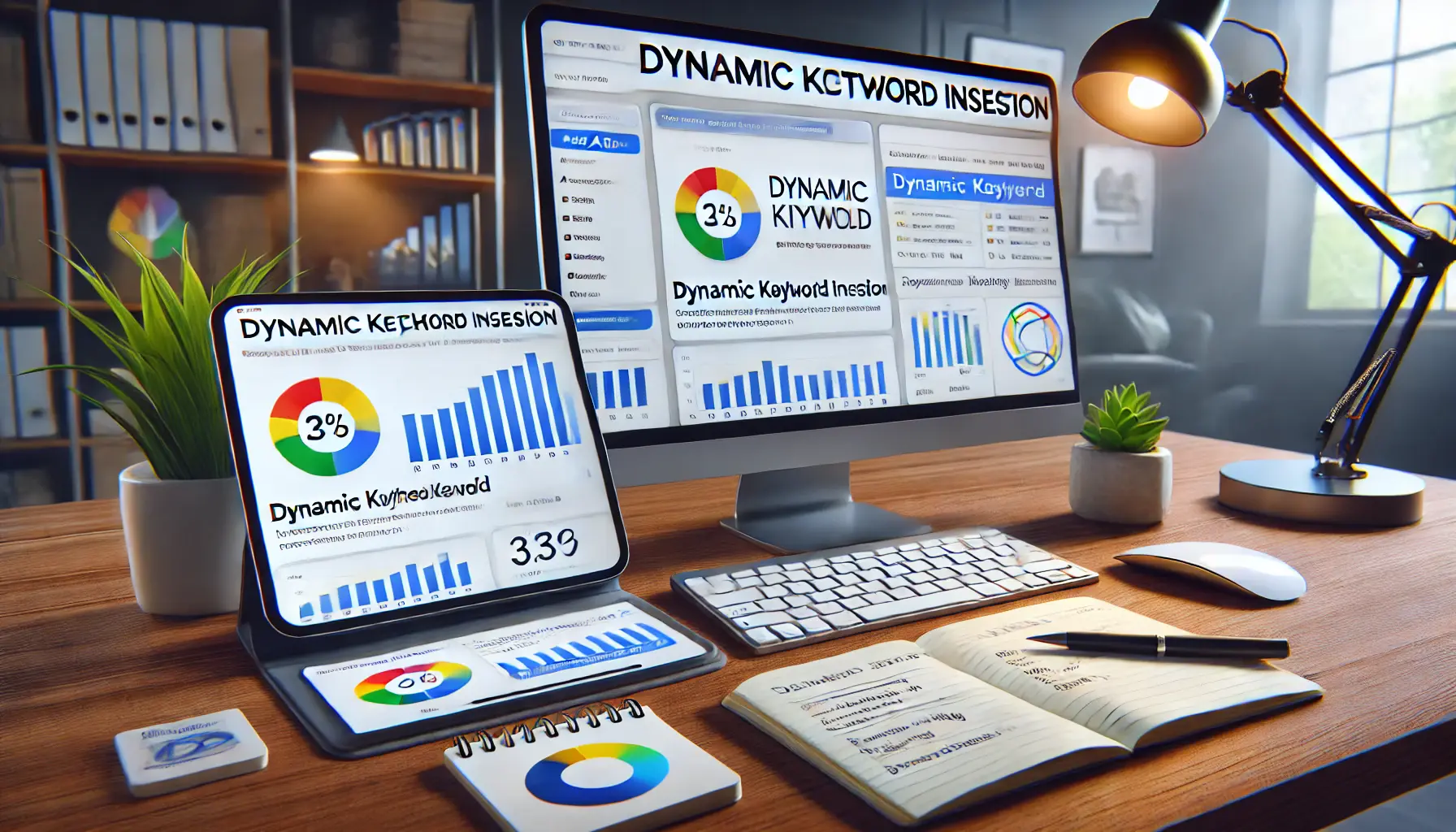
Highlighting the significance of Dynamic Keyword Insertion in Google Ads.
Why Dynamic Keyword Insertion Matters
Dynamic Keyword Insertion is invaluable for making ads appear more personalized and directly relevant to user intent.
By inserting keywords dynamically, each ad can better respond to users’ immediate needs, driving stronger click-through rates and enhancing campaign success.
For marketers, DKI provides a way to create ad copy that is adaptive and responsive in a competitive digital landscape.
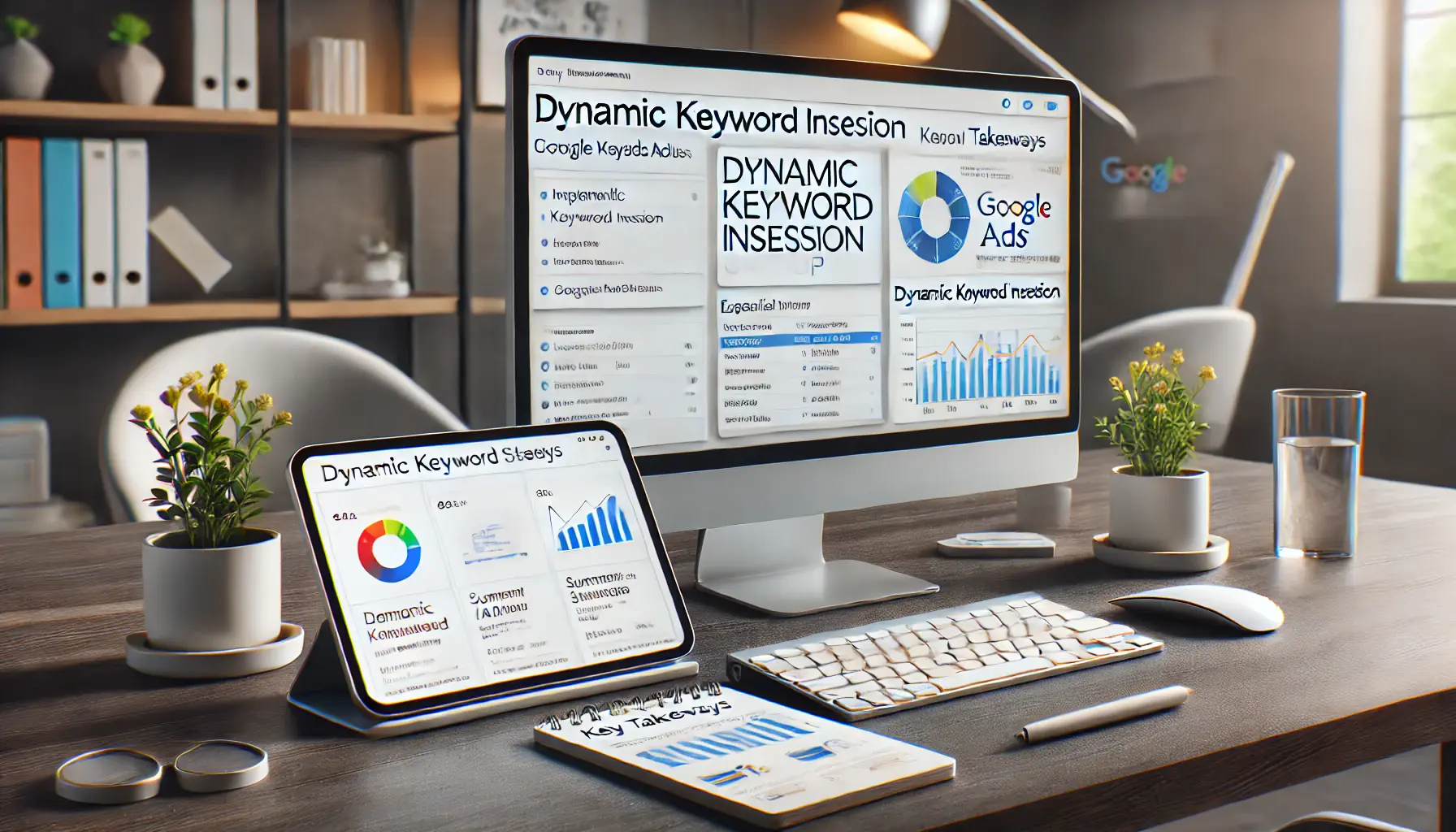
Essential strategies for implementing Dynamic Keyword Insertion in Google Ads.
Key Takeaways to Implement Dynamic Keyword Insertion
To implement Dynamic Keyword Insertion effectively, keep these key points in mind:
- Understand the Basics: Master the initial setup of DKI. Ensure that keywords align with the ad’s purpose and that the default text offers relevant fallback when needed.
- Personalize for Relevance: Use advanced methods, such as combining DKI with ad customizers and audience targeting, to serve ads that resonate with specific user segments.
- Monitor and Refine: Regularly analyze your ad performance, tracking Quality Scores, conversion rates, and the impact of various keyword formats. Adjust your campaigns to keep them optimized and responsive.
- Consider Alternatives: While DKI is a powerful tool, alternatives like ad customizers or responsive search ads may better suit certain campaigns.

Optimizing ad performance through advanced strategies in Google Ads.
Maximizing Results with Advanced Strategies
To truly maximize the potential of Dynamic Keyword Insertion, explore advanced strategies that take your campaigns further.
Experiment with different keyword match types, combine DKI with ad customizers, and incorporate audience targeting for even better results.
When your keywords and messaging style align with your brand, your ads feel natural and trustworthy, encouraging users to engage.
To sustain high performance, continuously monitor your campaigns and optimize based on real data.
Use the Search Terms Report to identify effective keywords, adjust bids for high performers, and add negative keywordsKeywords used to prevent ads from showing in irrelevant searches. as needed.
These ongoing optimizations help keep your campaigns fresh, relevant, and effective, achieving long-term success.
By mastering Dynamic Keyword Insertion and adhering to best practices, you can create campaigns that capture user attention, boost engagement, and drive valuable conversions.
As you gain experience and refine your strategy, DKI can become one of the most powerful tools in a digital marketer’s arsenal.
DKI offers a way to create highly relevant ads by matching user search terms, but using it effectively requires understanding both basics and advanced strategies.
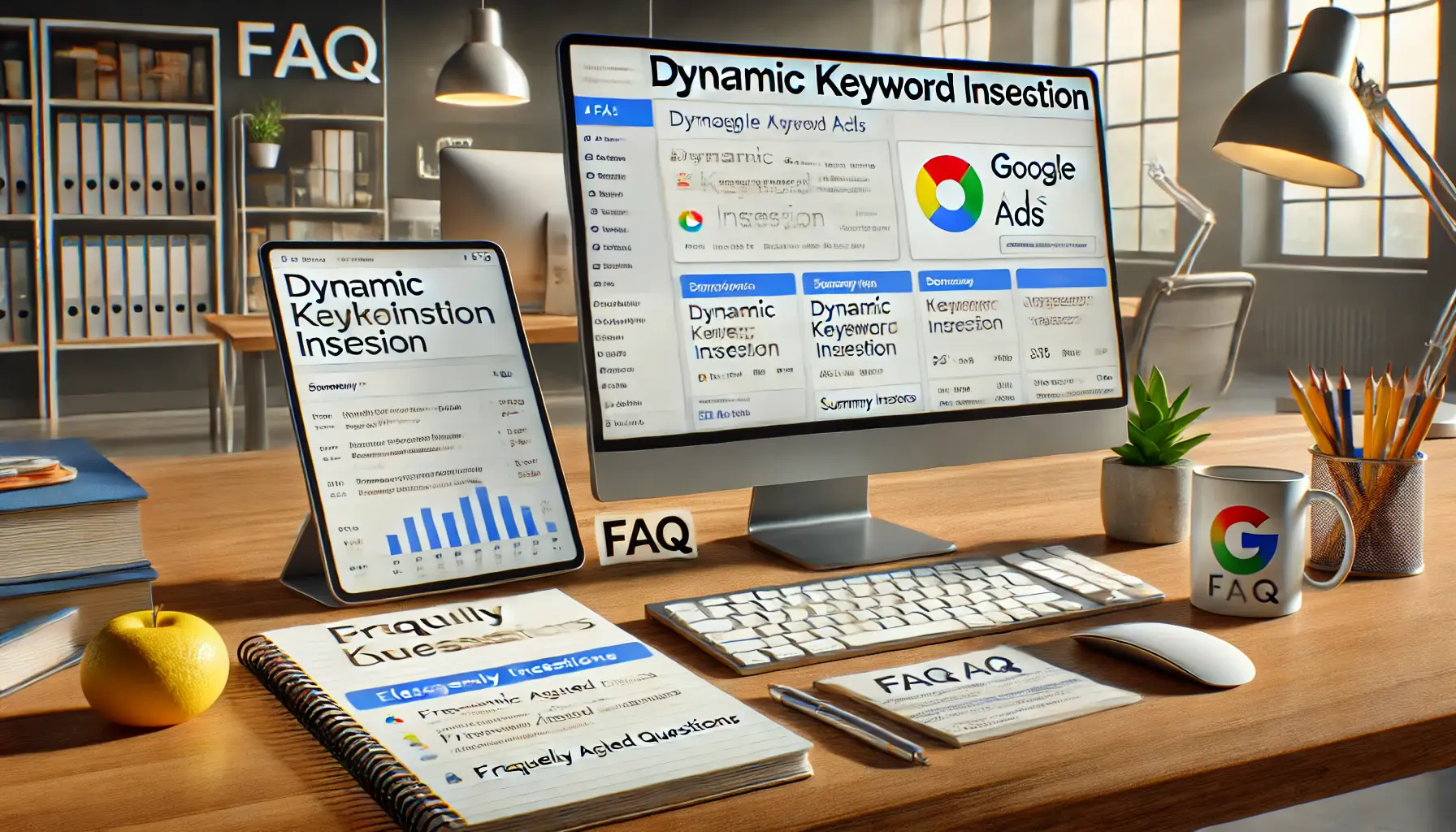
Addressing common questions about Dynamic Keyword Insertion in Google Ads.
Your campaigns can be managed by an agency specialized in Google Ads, check out our service page.
Dynamic Keyword Insertion Frequently Asked Questions
Here are some of the most frequently asked questions about Dynamic Keyword Insertion within Google Ads, covering everything from setup to advanced strategies.
These answers will provide clarity on implementing DKI effectively in your campaigns.
Dynamic Keyword Insertion automatically customizes ad text to match users’ search terms, making ads more relevant and increasing the likelihood of a higher click-through rate.
When users search, DKI inserts matching keywords into ad copy.
The format is usually {Keyword:Default Text}, with Google substituting relevant search terms to match user intent.
Yes, by enhancing ad relevance and click-through rates, Dynamic Keyword Insertion can improve Quality Score, leading to better ad rankings and lower costs per click.
DKI is most useful when targeting multiple keywords within the same theme or product category, allowing ad copy to respond dynamically to specific search terms.
Yes, risks include irrelevant or spammy ad copy if DKI is not managed well.
Carefully select keywords to ensure ads remain professional and relevant to user intent.
Use a targeted selection of high-intent keywords that fit naturally within ad copy.
Avoid excessive keyword use, as it can degrade ad quality and violate Google’s policies.
Yes, combining DKI with ad customizers enables highly personalized ads with additional dynamic information, such as location or product attributes, enhancing relevance even further.
No, DKI may not be suitable for every campaign, particularly those with strict brand guidelines or messaging requirements.
Alternatives, such as responsive search adsA type of Google Ad where multiple headlines and descriptions are tested for best performance., may be more appropriate in these cases.
Review DKI performance regularly, ideally every week or two, to track metrics like Quality Score, click-through rates, and conversion rates, allowing for timely adjustments.











